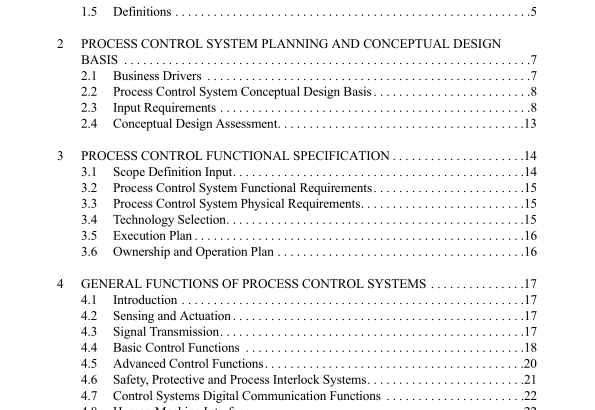API RP 554-1:2007 pdf free download.Process Control Systems Part 1—Process Control Systems Functions and Functional Specification Development
1.5 DEFINITIONS
The following terms and definitions are used in this document. Additional definitions are provided in Parts 2 and 3 when neces- sary to support the content of those documents. Batch Control: Refers to control functions that occur in a series of complex steps or phases that may combine continuous con- trol, sequence control and discrete control to execute a processing scheme.
Business Network: Refers to a digital communications network that is used for general purpose business use such as desktop computing, non-process control data base applications or other general purpose applications. Typically, business networks use industry standard communications methods such as Ethernet.
Continuous Control: Refers to control functions that are continuously and repetitively executed to control the values of process variables such as pressure, temperature, flow, etc. that are part of a continuous process such as a refining process, or within a portion of a process associated with a batch control system.
Control Loop: Refers to that part of an instrument control system which includes the input sensor, transmitter, communication path, control algorithm and final control element. Control algorithm may be executed as one of many such algorithms in a Process Control System or be performed by stand alone electronic, pneumatic or mechanical devices.
Demilitarized Zone (DMZ): Refers to an additional digital communications network that is inserted between a network that is exposed to the internet and public use networks and a protected network. In practice relative to this Recommended Practice, a DMZ is located between a business LAN and the process control network.
Discrete Control: Refers to control functions that involve on-off operations and interlocks. Discrete control variables are gen- erally associated with thresholds above or below which a control action is taken. The control action is a discrete function such as opening or closing a valve, starting or stopping a motor, etc.
Encryption: Refers to the coding and decoding of data transmissions using algorithms and encryption keys that are known only to the sending and receiving devices. A wide variety of encryption techniques and algorithms are available and have varying levels of security associated with them.
Enterprise Resource Planning (ERP): Refers to systems that are used to identify and coordinate supplies of raw materials, intermediate materials, finished products, consumables and other material or resources required to operate a manufacturing business.
Ethernet: Refers to a networking standard that uses a single cable consisting of 4 pairs of wires to connect multiple computing devices together in a manner that does not require that any of the devices be aware of the other devices. Ethernet is an asynchronous communications method that allows messages to collide and which provides for a collision detection and a random pause and retry means of allowing multiple devices to communicate. Ethernet standards are defined in the IEEE 802.x series of standards.
Extensible Markup Language (XML): A meta-language written to allow for the easy interchange of documents on the World Wide Web or among computers using Web based software tools.
Fieldbus: Refers to a digital communication network that connects the field sensors, transmitters and control actuators together and to either a controller or control network. A fieldbus network allows devices to send and receive messages over a shared path. Devices may send current measurements and/or diagnostic messages and receive commands or configuration data.
Field Devices: Refers to any sensors, measuring devices, control elements etc. that are used to sense or directly control process conditions.
Firewall: Refers to a combination of hardware and software installed on computers and network connections to prevent undes- ired messages from a digital network from reaching or passing through the computers. A firewall may also hide the presence of a computer from other computers on the network.API RP 554-1 pdf download.API RP 554-1:2007 pdf free download
